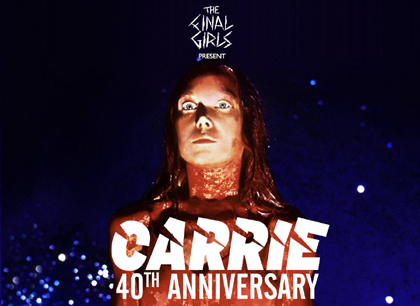FINAL GIRLS U.K. EVENT AT SCALARAMA; ALSO, REVIEW FROM BLOGGER WHO JUST WATCHED 'CARRIE'
 The Final Girls (Anna Bogutskaya and Olivia Howe) hosted a screening last night of Brian De Palma's Carrie at the ICA in London. The screening, which was part of Scalarama film month, was followed by a panel discussion made up of Michael Blyth (BFI Festivals Programmer), Catherine Bray (Film4 Editorial Director and Producer) and Dr. Alison Pierse (Lecturer at York University). The discussion is summarized by Smoke Screen's Owen Van Spall:
The Final Girls (Anna Bogutskaya and Olivia Howe) hosted a screening last night of Brian De Palma's Carrie at the ICA in London. The screening, which was part of Scalarama film month, was followed by a panel discussion made up of Michael Blyth (BFI Festivals Programmer), Catherine Bray (Film4 Editorial Director and Producer) and Dr. Alison Pierse (Lecturer at York University). The discussion is summarized by Smoke Screen's Owen Van Spall:Brian de Palma's films and his own statements have been controversial to say the least, something the Carrie panel tackled right from the start of their conversation. This is a film that begins with a tracking shot that has become somewhat notorious; the camera journeys through a steamy changing room as Carrie’s high school gym class are seen in various stages of nudity. This is far from the last time in the movie de Palma’s camera will linger on female flesh either: with female cheerleaders on the pitch and high school bad girl Chris’s bra-less torso getting plenty of screen time. This is also one of many de Palma films that put their female characters through the wringer, to put it politely.Thus the panel agreed that at some point they had all been driven to ask themselves: “Is it cool to like Carrie [and de Palma]?” But the consensus was that, after repeat viewings and after taking a few steps back to reconsider de Palma’s career as a whole, rejecting Carrie entirely as mysoginistic felt too much like throwing the baby out with the bathwater. Alison Pierce for example praised the way the film - largely through Sissy Spacek’s intense performance - effectively transmitted the desperate sadness of the plight of this hapless but incredibly powerful young woman. You empathise with Carrie as almost a Frankenstein-like figure, a victim created by monstrosity. The panel also noted how both De Palma and King explored her victimhood in interesting ways - with the narrative and characterisation of Carrie seeming at times to provoke the viewer to almost want this pathetic figure to get tormented. De Palma arguably manipulates viewers to effectively swing between delighting in seeing Carrie suffer, and yearning to see her inflict terrible vengeance on her tormentors turn. The bucket of blood sequence, with its long, almost gleeful build up in slow motion, was much discussed as an example of this. Viewers might want to ask themselves; do you maybe sneakily want that rope to be pulled, and the bucket to fall, knowing both what the immediate humiliating result will be, and what will happen next?
Author Stephen King and de Palma also have an interesting kingship, as Catherine Bray noted: they are good at “serious fun” - taking a ludicrous concept and imbuing it with genuine terror and emotional weight. Of course, Carrie can simply be enjoyed as campy, shlockly fun, with Michael Blyth half-joking if you could convert this film easily into a musical given its tone and setting. Regardless, the panel noted that the film remains very striking from a cinematographic perspective, with a visual approach that teeters on the deliciously overblown at times. De Palma throws in a tonne of tricks that he would become well known for, including diopter lens shots, and the use of montage which really works well in the prom terror sequence, as Carrie starts to come apart, her attention and powers jumping to various points as she singles out her enemies for destruction. The Smoke Screen in particular was struck by the deliriously bold lighting throughout the film too. Much of the film’s early sequences seem drenched in a warm, apple pie glow, but in the prom night sequence sees de Palma start us off with a dreamy kaleidoscopic mix of purples and yellows that highlight how carried away Carrie is by her one moment of bliss, only to drench the entire affair in an insanely deep red shade once the psychic assault starts.
HARRY FAINT JUST WATCHED 'CARRIE' (SEEMINGLY FOR THE FIRST TIME?)
Meanwhile, blogger Harry Faint posted a brief review after watching Carrie, seemingly for the first time:
Even though I knew the plot and knew the rampage that was about to ensue when the bucket finally dropped, I was still in shock. The build up of this film is masterful, with the final slow motion sequence becoming a sickly sweet fantasy. The narrative is relatively simple and the pace is snappy, which makes the final sequence all the more painful to watch as carnage unravels as quickly as Carrie’s happiness. I was pleasantly surprised with how much I enjoyed it. There is an interesting use of De Palma blurring two images into a shot and I came away feeling that every visual was vital to the story – the prom sequence is such a great accomplishment in filmmaking. It felt real, Carrie’s telekinesis is never questioned or explained as the supernatural. In fact, nothing is over explained, or if things are explained it is through use of visuals and absence of voice. However, one thing I disliked is the reuse of Herrman’s 4 notes from Psycho (Hitchcock, 1960), but it still works.Hearing the bucket swing back and forth and nothing else is as clever as it is haunting. You know you like a film when you wake up the next morning still thinking about it.



